

Home Site Search Contact Us Subscribe
|
|
|
|
Exhibition Review: "Portable" at Storefront for Art and Architecture through August 5
Three artists consider the nomadic impulse to brave the unknown and the sedentary urge to hoard and build by Laurie Manfra July 17, 2006 A small exhibition at the Storefront for Art and Architecture in New York City beckons us to consider the unforeseen consequences of two emphatically American desires: the nomadic impulse to brave the unknown and the sedentary urge to hoard and build. Curated by Yasmeen Siddiqui, a recent graduate of Bard's Center for Curatorial Studies, “Portable” presents the work of three young artists: Linda Ganjian, Kim Holleman, and Marie P. Sauvaitre. Inside the dimly-lit, open-air gallery, Siddiqui pairs three of Ganjian's intricate sculptures – utopian, Lego-inspired visions of the industrialized city painstakingly constructed on old rugs – with 10 photographs produced by Sauvaitre over the last four years of nomadic dwellings in France, Israel, Jordan, and the U.S. A short walk across Lafayette Street in Lt. Petrosino Square, where a few of New York’s homeless wile away the hours, Bushwick, Brooklyn-based artist Kim Holleman has converted the interior of an old trailer into an unexpectedly delightful retreat featuring greenery and two built-in benches.
“I was interested in exploring how our economy has shifted the concept of the nomadic,” says Siddiqui, a medievalist scholar whose research uprooted her from Toronto and landed her in New York after a brief stint in Cairo. Allowing her studies to chart her destinations, the circumstances of her own existence have fluctuated over the last decade. "But now the concept of nomadicism has been usurped by the transnational. There are still nomads, but they've lost their place. I was interested in provoking that paradox," she says, suggesting that while the term “trans-national” often encompasses individuals or companies operating across national borders, the nomadic evokes a romantic subversion or blatant disregard for such boundaries.
Culled from Sauvaitre’s “Errances” collection, which translates from French to mean "between wandering and exile," the 10 chromogenic prints are spaced along three of the gallery’s angled walls. Their placement arouses a psychological wandering that takes you from Slab City, California, where an evangelist’s trailer proclaims the word of God, to Negev, Israel, where a few haphazardly assembled shacks perch atop a cliff like bird nests in a tree. The abodes she captures range from mass-produced mobile homes to patched and weathered shanties draped with textiles and adorned with branches that evoke images of the primitive huts that once intrigued German architectural anthropologist Gottfried Semper. As an exile living in London during the Great Exhibition of 1851, he published Four Elements of Architecture, the first of which maintained that the earliest homes consisted of rugs and woven mats hung like tablecloths over skeletal supports.
Set low on pedestals in the center of the gallery are Ganjian’s three marvelously detailed sculptures that map birds-eye views of cities overgrown from their invisible grids like woven patterns projecting skyward off a Persian rug. The artist sees herself as working within the weaver’s inherently subversive craft, which borrows and modifies historically charged symbols and motifs passed down over time and across cultures. The daughter of Armenian-Turkish immigrants, she recounts her parents’ one regret: they were unable to bring with them to America the generations-old carpets that were once cherished possessions of their families. “I guess I am filling in the void,” she says.
As a Long Island City local since 2005, Ganjian draws inspiration from the Queens neighborhood where she works. As a former prop-maker, she’s honed an assemblage approach to making, which seems to guide her search for meaning. “My impression of Linda is that she has a very strong connection to place, especially in terms of her not desiring to leave,” Siddiqui says. The title of one of her pieces, L.I.C (Lovely Infrastructure Capriccio), which took 14 months of meticulous hot-gluing to complete, pays homage to the Queens community where it was built.
The exhibition’s final component demands a brief journey beyond the gallery’s shaded confines. Installed across the street at the northern edge of Lt. Petrosino Square is “Trailer Park,” the recycled bunker that Holleman gutted and retrofitted with an interior garden. It’s a park-within-a-park that challenges your perceived relationship to nature while offering a welcome respite from it. “She’s playing with the idea of bringing the outside in and questioning how we idealize the natural world and tame it,” Siddiqui says.
Only after signing a waiver of liability are you allowed to board the parked tag-along, a suitable precaution should you stumble on one of the enormous custom-built concrete-and-brick planters that occupy the interior space. Holleman has transformed a portable home into a hefty public garden that seems to throw caution to the wind by compromising the R.V.’s most functional attribute, its light weight. Once inside, there’s actually nothing menacing about it. At certain times of the day, when sunlight beams in through the overhead skylights at just the right angle and intensity, you purportedly can tell the time by the sun-dial garden ornament she’s placed in the dirt. “Holleman’s a builder and an idealist,” Siddiqui says. Perhaps that’s why she’s determined to set the trailer at various sites throughout the city. In an ongoing collaboration with veteran educator Lois Stavsky, who runs Gallery 438 at nearby Seward Park High School, the installation will travel to a number of public schools this year. “Trailer Park” will also be part of Ed Woodham’s Art in Odd Places show, which will scatter a variety of artworks across the Lower East Side from September 4 through October 1, 2006.
To accompany “Portable,” Storefront has printed a newspaper-format catalogue that presents a conversation between the artists, led by the curator via e-mail last month. “It was more of an experiment,” Siddiqui says. “I wanted to let them speak to each other to uncover meaning, rather than impose it in the usual curatorial essay.” Cautious not to obscure their different approaches with sweeping statements, she asked them to speculate on what unites their work. Responding to Ganjian’s handcrafted urban mazes Holleman says, “The landscape in her mind [seems] even vaster, even more epic than what makes it into her sculptures.” And in response to Sauvaitre’s documentary photographs, Ganjian says, “Marie’s work suggests to me how vulnerable and insignificant human life is compared to the massiveness of nature.” Sauvaitre encapsulates the work of all three with, “All of us are physically using the landscape…to try and approach something personal, emotional, [and] sublime in its materiality.”
Siddiqui’s open-ended approach is a refreshing departure from the usual, often relentless, grand proselytizing about art and intentionality. And as this is Siddiqui’s first, independently-curated show in New York, it represents a promising start for a reverent scholar. “Portable” will run through August 5, 2006 at the Storefront for Art and Architecture, 97 Kenmare Street, New York City.
Laurie Manfra is a Long Island-based writer with a B.A. in Architecture from Columbia University. Currently, she is at work on a book documenting the integration of the aeronautic software program CATIA into the Gehry office in the early 1990s. |
(click on pictures to enlarge) 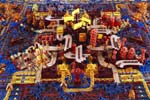 (Linda Ganjian) Linda Ganjian: L.I.C. (Lovely Infrastructure Capriccio)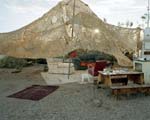 (Marie Sauvaitre) Marie Sauvaitre: Slab City, California; chromogenic print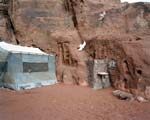 (Marie Sauvaitre) Marie Sauvaitre: Wadirum, Jordan; chromogenic print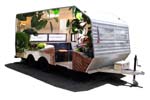 (Kim Holleman) Kim Holleman: Trailer Park, rendering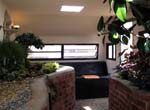 (Kim Holleman) Kim Holleman: Trailer Park’s interior brick-and-cement planters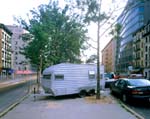 (Stefan Hagen/Courtesy of Storefront for Art and Architecture) Holleman’s Trailer Park in the park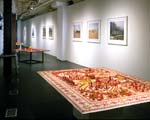 (Stefan Hagen/Courtesy of Storefront for Art and Architecture) Ganjian and Sauvaitre installation |
© 2006 ArchNewsNow.com